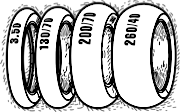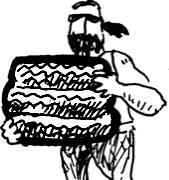Tires
Related Topics
Pneumatic tires - contact point to the road surface
Without the invention of Messrs. Thomson and Dunlop - everyone knows the latter, the former rather unknown gentleman had applied for a pneumatic tire patent 40 years before Dunlop - Harley riding would probably only be half as smooth. Perhaps motorcycles would not even have been invented. Pneumatic tires not only provide a certain level of suspension comfort while riding, their construction provides the basis for everything that is important when riding: power transmission during acceleration and braking and lateral control straight ahead and in curves. The flexible surface interlocks with the base on a microscopic scale, and its flexibility also increases the contact area.
Slicks or tread?
On the circuit, motorcycles use treadless tires, at least in dry conditions. The reason for this is to maximize the contact area for transmitting acceleration and braking power on a flat, dry asphalt surface with optimum adhesion. Of course, the Harley rider does not have this comfort on the road. You have to deal with moisture and wetness, dust, dirt clods, crop residues of the vegetable kind, and who knows what else. That's why non-racing tires have tread. The tire vulcanizers, even when motorcycles were very young, found that they could make the lives of their customers considerably easier by adding bumps to the rubber covers of the tires. Knobs and small rubber blocks were the forerunners of today's very sophisticated tread designs. Tread not only drains rainwater to the side, it also provides better road contact. And coarse lug tread, like on Bates' X-Country Baja tires, is designed for traction even in muddy and difficult conditions.
Aging tires
That tread degrades over time is obvious. And that anyone who values the functionality of the tread (optimum grip, water drainage) therefore has to change tires from time to time is also clear. But if you're lucky enough to catch a tire that's ten or fifteen years old and whose tread hardly wears out, can't you still count yourself lucky that it'll certainly last another ten years? Very probably not.
Chemical-physical processes cause tires to age, and unlike a barrel-aged good wine, this does not mean that they automatically get better. Ozone and UV rays cause the rubber part of the tire to become brittle, and the plasticizers also steam out of the rubber over time. The remaining material develops fine cracks into which moisture can penetrate. When the tire is so old that the tread hardly wears off, it is also so hard that the surface interlocks poorly with the ground. Braking distances then become longer and longer and curves are better taken in crawl speed.
So, old rubber, which may provide authenticity on a museum piece, has no place in real life on the road and off-road.
Do you have to break in new tires?
Tire rubber is a mixture of different rubbers, carbon black, silicon oxide, sulfur and a few more secret ingredients. The tire is given its final shape, including the tread, under heat in a baking mold. The tire factory uses release agents so that the tire can be removed from the mold without damage. These release agents still adhere to the tread even after it has been mounted on the rim and are the reason why tires should be run in with care for about 100 km. Only after this time and several warm-ups and cool-downs does the tire reach its final microstructure. Braking performance, lateral control and power transmission during acceleration are only optimal after running-in.
Are there different tire designs?
You can hardly tell by looking at the rubber rings, but a lot of knowledge and experience goes into a tire on a Harley-Davidson. Even in the days when the invention was still young, a pneumatic tire consisted of more than just rubber and a few additives. In order not to get out of shape and to remain stable despite high air pressures, reinforcement in the form of fabric plies was incorporated from the very beginning.
Currently, three different types of fabric plies are used. There are therefore tires in so-called
- Diagonal construction (code letter in the tire size: -)
- Radial construction (code letter R) and
- Bias belted construction (code letter B).
The diagonal construction tire is the most original of the three. The fabric plies of the tire substructure (carcass) are laid on top of each other in such a way that the threads run at an angle from tire bead to tire bead. The cross-ply tire is very stable in lateral inclination, but grows in circumference at high speeds. The contact patch is long and narrow, not very pronounced toward the sides. The tire may appear somewhat tippy. Many drivers do not like this and therefore unconsciously limit the angle of inclination in curves quite early, before any component could graze.
In the radial tire, the carcass threads run at a 90° angle across from bead to bead. This gives the tire a somewhat more compliant sidewall than a bias-ply tire. To prevent the tire from inflating at high gea speeds, a belt of Kevlar or nylon cords runs centrally under the tread once around the tire. The belt threads run only slightly at an angle. (Special case: steel belt with 0° alignment, this is really stable!) Through the belt, a radial tire hardly grows at high speeds. Due to the yielding tire sidewalls, the contact area ("patch") is much wider than on a bias-ply tire. In the curve this gives a confidence-building leaning feeling.
The Bias Belted has two additional belt plies above the diagonal tire's diagonal fabric plies, which stabilize the tire's circumference. The belt is usually made of aramid, and the threads are arranged at a slight angle, which is much smaller than the angle of the diagonal base. You have to like this combination of advantages from both worlds, but it can ensure that the wobbly cornering becomes a stable experience.
And where do the so-called bead strips for our vintage classics fit in? Bead strips have always been made in diagonal construction, the most original construction method, as I said. The only difference is that beaded strips do not have a wire insert.

Have any questions?
Our service team will be glad to help out: Mondays - Thursdays 08:00-17:00 CET, Fridays 08:00-16:00 CET, Phone: +49 / 931 250 61 16, eMail: service@wwag.com


